LOL @ CU
Featured
Welcome to the homepage for Cornell University’s Landscapes and Object Laboratory.
Located in Stimson Hall, the LOL is dedicated to the analysis and interpretation of archaeological materials. Our projects focus on exploring the role of the material world–from landscapes and places to assemblages and singular artifacts–in human social life.
This web site is intended to provide news of LOL events, synopses of current projects, access to public data sets, and resources for LOL team members. The LOL is open for student use at any time when other events are not scheduled in the space. Check the LOL calendar to see upcoming events. And write to Adam Smith or Lori Khatchadourian if you have a CIAMS-related event you want to host in the LOL.
Uncovering ancient forgeries in the Cornell Coin Collection
After a long hiatus due to the ongoing Coronavirus pandemic, the LOL pXRF (Portable X-Ray Fluorescence) spectrometer was once again called into action at Cornell’s Rare and Manuscript Collections Library (RMC). Cornell graduate students and researchers have utilized the CIAMS pXRF for a wide range of cultural heritage projects in the past, but this current project breaks new ground.
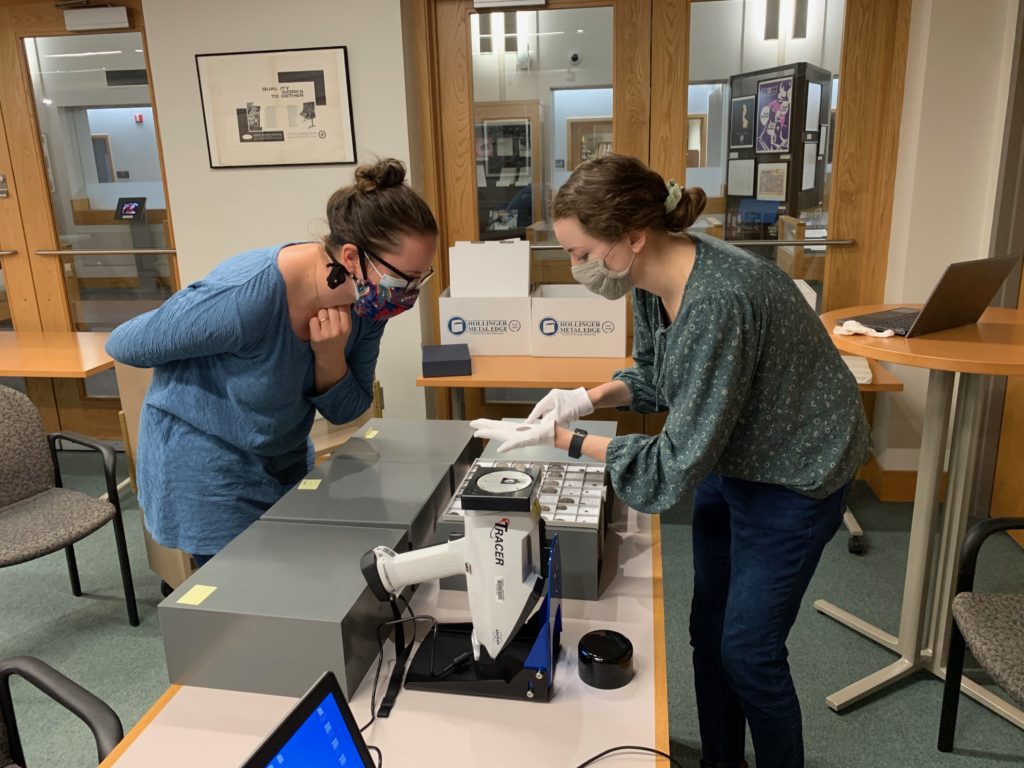
The Cornell Coin Collection contains about 1,500 Greek and Roman coins, but some of these coins might be ancient forgeries. Olivia Graves, a PhD student in Classical Archaeology, has conducted research on counterfeiting behavior in the ancient world and she recently noticed that some coins in the collection looked a bit “off.” Silver coins produced in the Mediterranean world from c. 400-50 BCE were almost purely silver and people typically counterfeited these coins by covering bronze or copper blanks in a thin plating of silver before stamping them and putting them in circulation. Upon closer inspection of photos in the collection’s online database, Olivia discovered that a few coins had flecks of green patina and orange rust on their surfaces – a clear sign that at least some coins in the collection are likely silver-plated counterfeits.
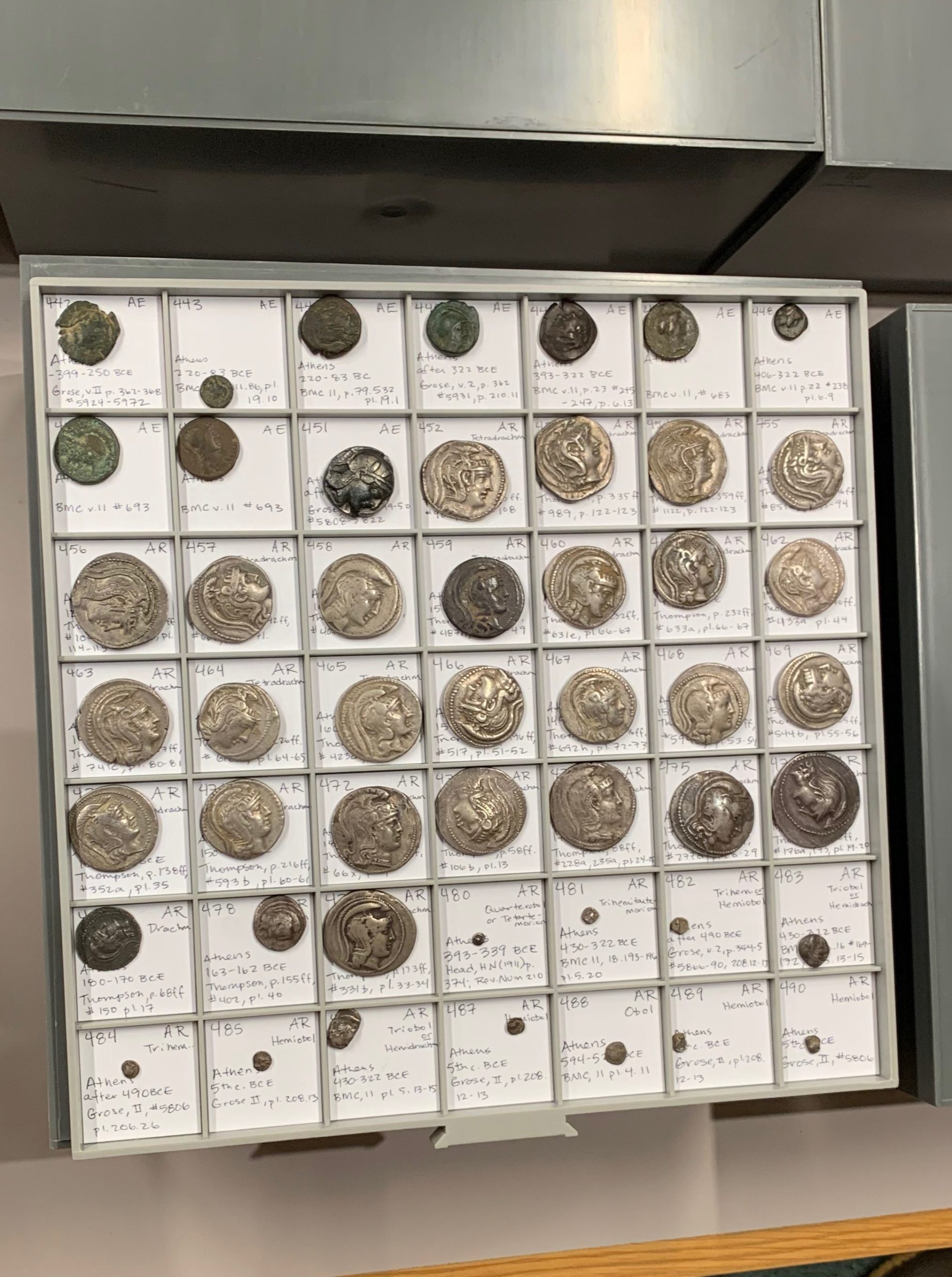
In order to test this theory, Olivia took the LOL pXRF to the RMC library along with Dr. Adam T. Smith, Director of CIAMS, and two post-doctoral researchers at the Cornell High Energy Sychrotron Source (CHESS), Dr. Louisa Smieska and Dr. Hazar Şeren. They tested 25 coins in their first preliminary visit; about half of these coins were suspected to be counterfeits and the other half were suspected to be real coins from similar time periods that could act as controls. These first tests provided some intriguing results. For example, two coins from a 2nd-century BCE mint from Athens were tested. The suspected-real coin gave results of over 98% silver on the surface. The suspected-counterfeit coin, on the other hand, turned out to be a metal cocktail: 80% silver with the remaining 20% made up largely of copper, tin, rhenium, and mercury! Yet another reason to wear gloves when handling artifacts.
These pXRF tests strongly suggest that the Cornell Coin Collection does indeed contain some ancient forgeries and Olivia hopes to conduct further tests in the coming months. Stay tuned!
pXRF Visits Cornell’s Rare and Manuscript Collections
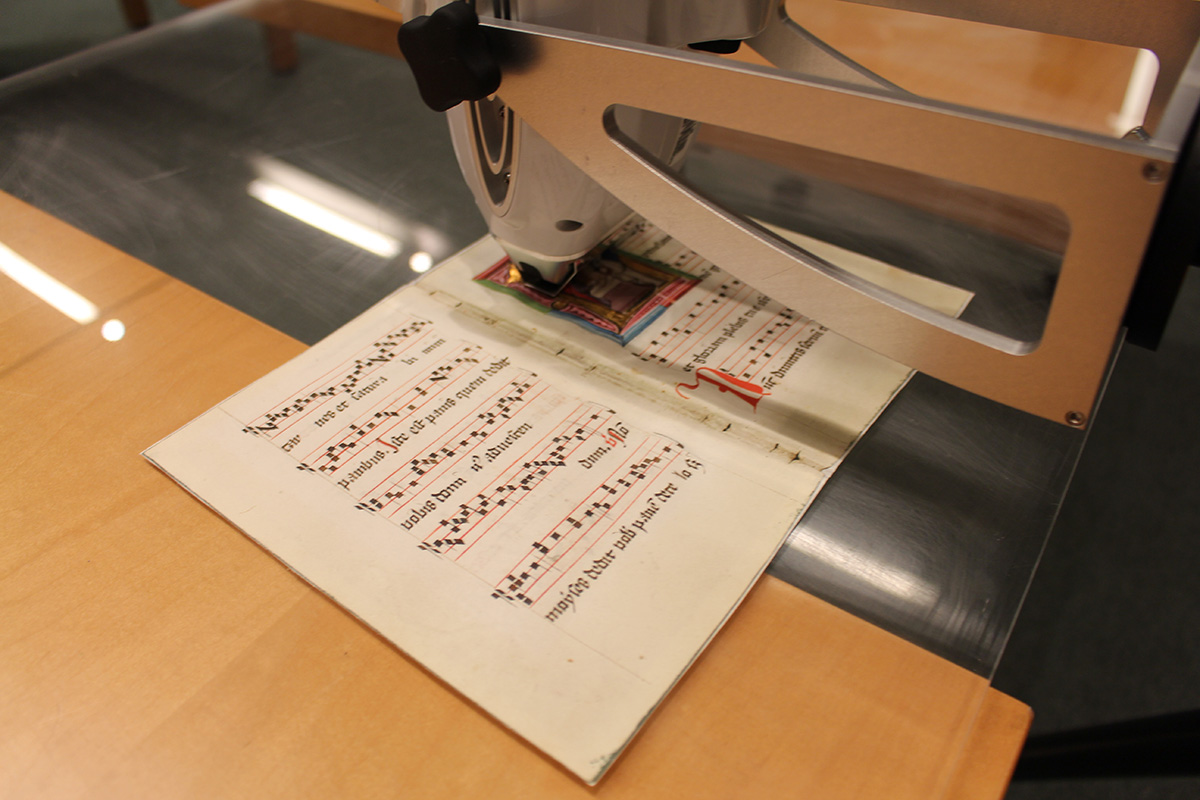
An early 16th century choirbook from Italy, depicting an illustration of St. Peter and assembled saints.
Portable x-ray fluorescence has found another application in cultural heritage research at Cornell. Over the course of three days in late February, the Landscape and Objects Laboratory’s portable XRF system was used to examine twenty-seven European illuminated manuscript fragments in the Cornell Library Rare and Manuscript Collections. Dr. Louisa Smieska, a postdoctoral researcher at the Cornell High Energy Synchrotron Source (CHESS), collaborated with Ruth Mullett, Medieval Studies graduate student, and Dr. Laurent Ferri, Curator of Pre-1800 Collections, to complete the study.
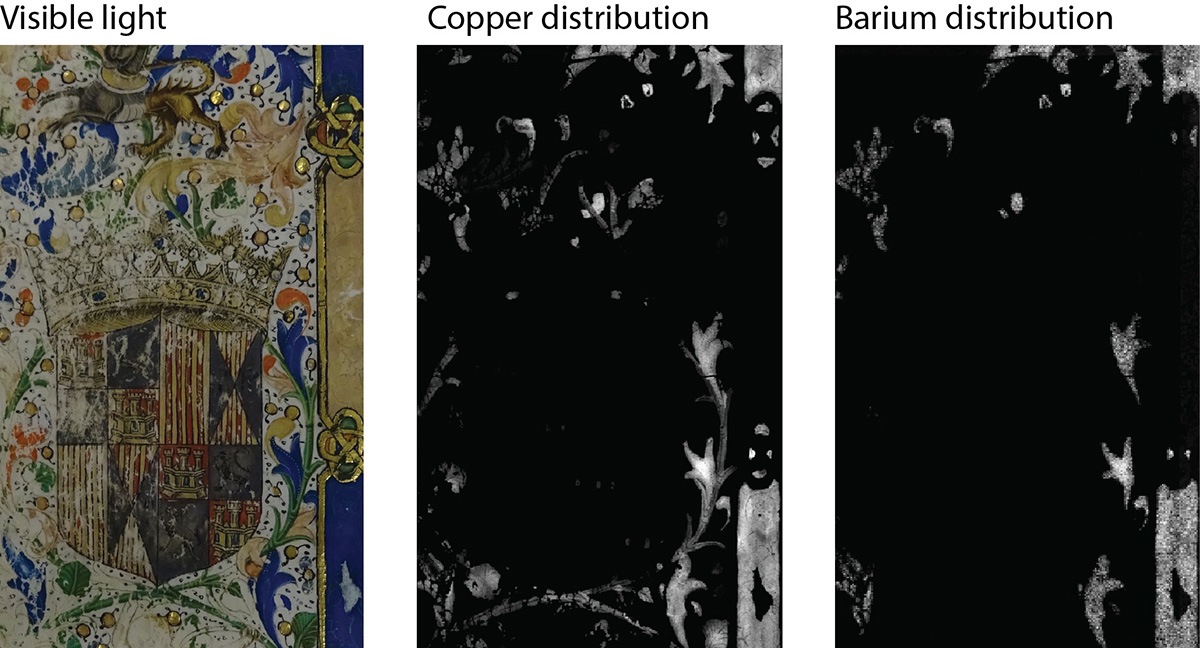
Detail of 15th century manuscript copper and barium distribution.
This survey was aimed at identifying the pigments used in the lavishly decorated pages in Cornell’s collection. The team was particularly interested in the blue pigments, and in metallic areas that could be gold. Twenty-three of the manuscripts examined contained copper-based blue pigments, which are probably dominated by the copper-rich mineral azurite. Some of these manuscripts will be examined further at CHESS later this spring to try to determine whether the other trace minerals in azurite blue regions reveal information about the pigment’s provenance. Three manuscripts yielded XRF spectra that could indicate the presence of the precious and costly blue mineral lapis lazuli; these fragments will need to be examined further to confirm this finding. One manuscript contained smalt, a ground cobalt glass, which is an unusual (but not unheard-of) pigment for illuminations.
In contrast with the scarcity of costly blue pigments in these manuscript fragments, eighteen of the twenty-one fragments with metallic regions contained gold. Although today gold is considered particularly valuable, the relative cost and rarity of lapis lazuli when these fragments were prepared may have been greater than gold. The survey also identified metallic regions containing tin, which could indicate mosaic gold, a synthetic tin sulfide pigment. The research team is excited to compare this pXRF data with other spectroscopic analyses in the coming months.
pXRF investigates pigments at the Johnson Museum
The Landscape and Objects Laboratory’s portable x-ray fluorescence (pXRF) system has once again visited the Herbert F. Johnson Museum of Art. Dr. Louisa Smieska, a postdoctoral researcher at the Cornell High Energy Synchrotron Source (CHESS) whose studies focus on materials analysis of cultural heritage objects, was recently trained in pXRF data collection at the LoL. On January 15, 2016, Dr. Smieska collaborated with Dr. Andrew Weislogel, the Askin curator of Earlier European and American Art at the Johnson Museum, to collect XRF data from selected regions in several 17th-century Dutch paintings and one 20th-century.
The goal of the study was to survey the pigments used to create these very different paintings, with a particular interest in the blue pigments. Several possible blue choices were available to 17th-century painters, including plant-derived indigo, copper-rich azurite, ground cobalt-rich glass (smalt), and the precious aluminosilicate mineral lapis lazuli (natural ultramarine). Knowing which one was used is important for understanding the original expense of the painting, since ultramarine was much more costly than the other options. Identifying pigments can also hint at how the original composition might have looked, since the color of indigo and smalt can fade over time.

Dr. Louisa Smieska (CHESS) and Dr. Andrew Weislogel (Johnson Museum) use the pXRF to examine van Schrieck’s Still Life with Thistle (ca. 1670).
Pictured are Dr. Smieska and Dr. Weislogel collecting pXRF data from a c. 1670 painting by the Dutch artist Otto Marseus van Schrieck. The blue thistle blossoms in this picture are painted with a copper-containing pigment, possibly azurite. The pXRF analysis of other locations in this painting indicated that the green pigment used in the thistle leaves is also copper-based, while the bright red details in a few of the butterfly wings are painted with a mercury-containing pigment, most likely vermilion. The results from this afternoon of analysis will be used to identify paintings that could be good candidates for scanning x-ray fluorescence imaging at CHESS in the next few months.
LOL’s pXRF Get’s Up Close and Personal with a Rembrant
On Thursday, April 9, Dr. Jennifer Mass, senior scientist, Conservation Research Laboratory, Winterthur Museum, served as guest lecturer in the the Mellon-supported interdisciplinary seminar ARTH 4605/6605: Art|Science Intersections: More than Meets the Eye, offered jointly by Dr. Andrew Weislogel, Askin curator of Earlier European and American Art at the Johnson Museum and Professor Lisa Pincus of the History of Art and Visual Studies. Core Cornell presenters for the course have included Professor C. Richard Johnson of the School of Electrical and Computer Engineering, Dr. Arthur Woll of the 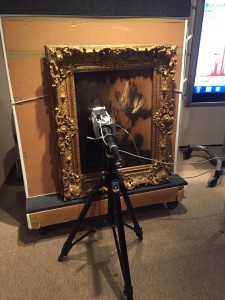 Cornell High Energy Synchrotron Source (CHESS), and Professor Sturt Manning of CIAMS.
Cornell High Energy Synchrotron Source (CHESS), and Professor Sturt Manning of CIAMS.
The loan of LOL’s handheld X-ray fluorescence spectrometer allowed Dr. Mass to demonstrate to students the process of distinguishing elements in historic pigments in the Museum’s School of Rembrandt Still Life with Dead Game painting, which had been the subject of prior investigations including x-ray fluorescence mapping at CHESS and microscopy of cross-section samples previously taken by Dr. Mass. In class the students were able to witness the XRF spectrometer detect mercury in the crest of one of the ducks’ heads, which indicates a bright vermilion red pigment that has since darkened to brown. The XRF device also detected cobalt, a key element in the 17th century pigment smalt, which is made from ground cobalt blue glass. This pigment also darkens to grey-brown over time. These real-time demonstrations were crucial for the students’ realization that the colors we see in historic paintings are often much different from what the original artists intended. Dr. Mass expertly guided the class in the demonstration, showing setup of the device and use of the software to distinguish between elements desired for the experiment and those of lesser interest that commonly occur.
Llhuros Returns to the LOL
As part of the course on the “Rise and Fall of Civilization”, the Civilization of Llhuros materials created by Norman Daly were back in the LOL for students to measure, describe, and interpret. The Cornell Chronicle has a story on the class and on the Llhuros Project here.
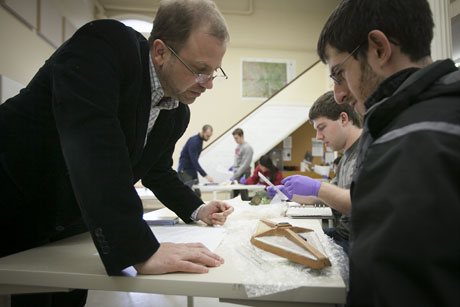
Prof. Adam T. Smith examines a Llhoroscan artifact with Jordan Silver ’16
Podcasting the LOL

RadioCIAMS taping with (from L to R): Shannon Dawdy, Kurt Jordan, Perri Gerard-Little, Chris Monroe, Nick Lashway, Cynthia Kocik, and Catherine Kearns
RadioCIAMS held it’s second “Conversation in the LOL” on Friday March 14 when we welcomed historical archaeologist and recent MacArthur Foundation Fellow Shannon Dawdy from the University of Chicago to chat about ruination, the archaeology of modernity, and the situation of the discipline in the early 21st century. The conversation proved to be provocative, illuminating, and always engaging. Listen on the RadioaCIAMS page. Stay tuned for more!
RadioCIAMS: Conversations in the LOL
The Cornell Institute of Archaeology and Material Studies kicked off its new RadioCIAMS podcast series with a conversation in the LOL with Dr. Joanna Sofaer. The discussion ranged from contemporary movements in bioarchaeology to the secrets of long-term collaborative research.

RadioCIAMS taping with (from L to R) Joanna Sofaer, Betty Hensellek, Liana Brent, Christopher Monroe, Nerissa Russell, Alex Marko, and John Gorczyk
You can find the podcast on the RadioCIAMS website.
LOL in the News: Cornell Institute of Archaeology and Material Studies
New press from the Cornell Chronicle on the Cornell Institute of Archaeology and Material Studies:
The institute includes 18 faculty members and a postdoctoral researcher from five departments (anthropology, classics, history of art, landscape architecture and Near Eastern studies) and two colleges (Arts and Sciences; Agriculture and Life Sciences).
“The new Landscapes and Objects Laboratory (in McGraw Hall) is a striking success in quickly becoming home to many of our graduate students, but already it’s too small for the number of anticipated students next year,” Manning said.
The complete story is here: Cornell Chronicle: Archaeology and material studies institute created.

